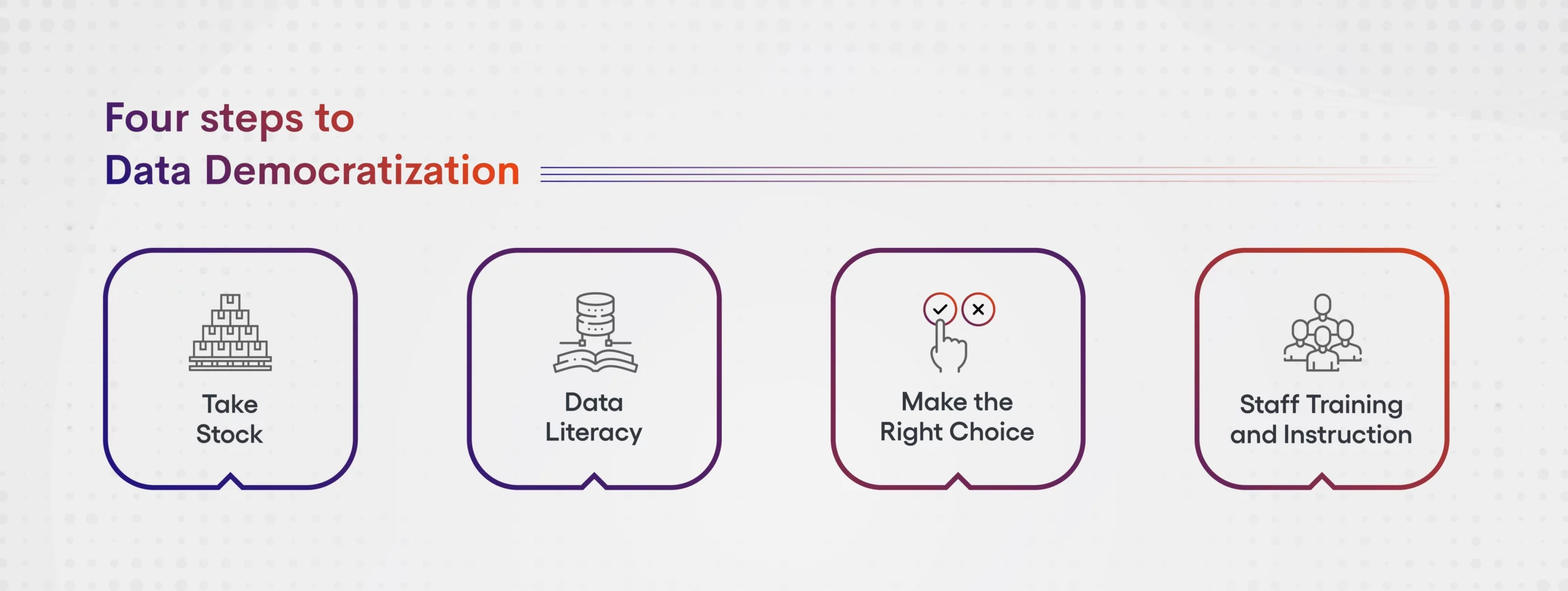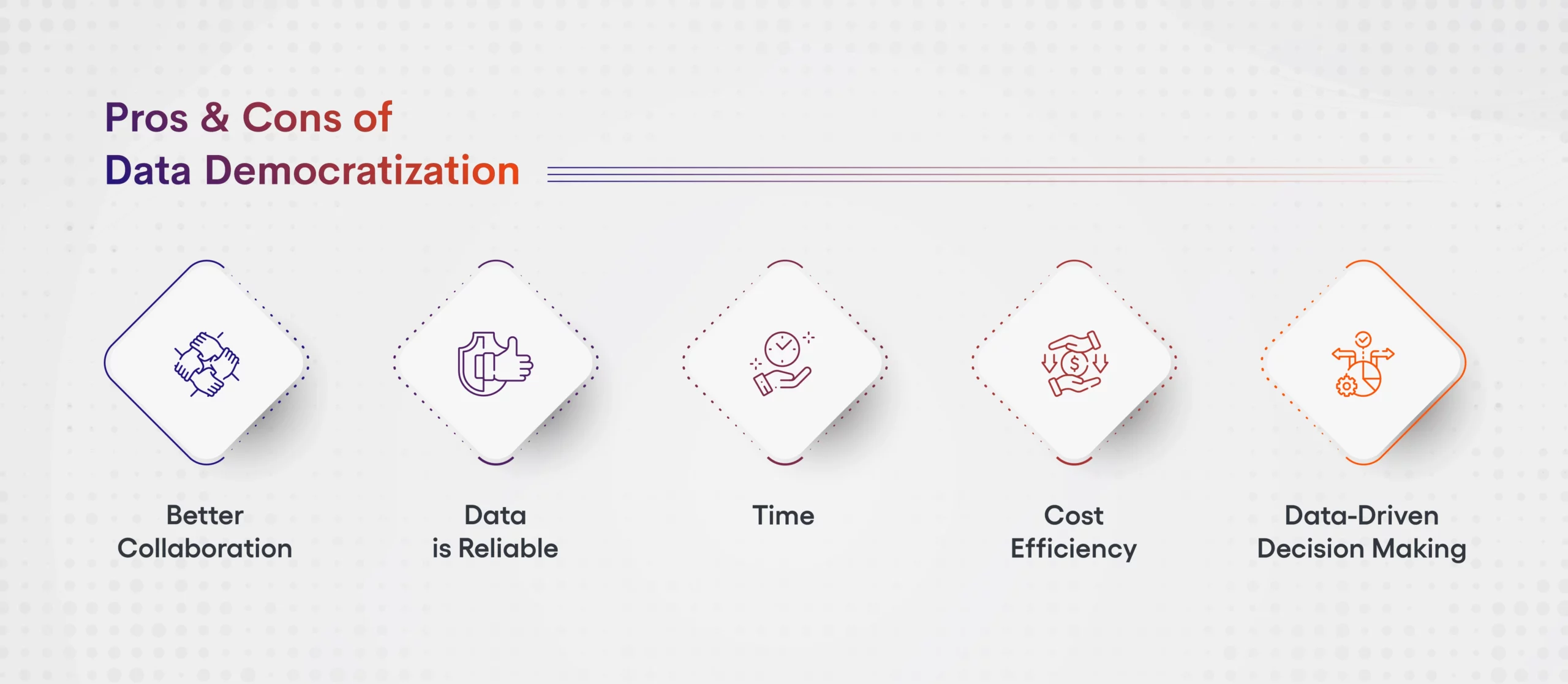- Blog
- April 18, 2023
Data Democratization – Steps & Best Practices

- Blog
- April 18, 2023
Data Democratization – Steps & Best Practices
The phenomenon of data accessibility and education for all employees and stakeholders, and regardless of their technical background is referred to as Data Democratization.
Before data democratization, enterprises would waste considerable time searching for data, accessing the data, and waiting for approval to use it. Traditionally, only IT teams retained most or all of the data. This was a major hindrance for the enterprise to be data-driven. Data democratization has various benefits such as greater efficiency, better profitability, and scalable growth. It is highly productive for Sales and Marketing giving them unhindered insight into the products and services thereby enabling them to streamline opportunities and designing appropriate campaigns.
Data democratization is great to facilitate better customer experience by making the process of support almost instantaneous. Whether it be over a call, chat or chatbot, access to data pre-hand makes the process smooth and swift. Amongst peers and organizations, data democratization brings in a level of transparency and awareness. Additionally, it helps especially in remote and hybrid working environments where the remote employee may need access to information on a regular basis.
Knowledge is power. Enterprises that fail to provide their employee’s adequate knowledge or data face many roadblocks –
- Data silos: When data is stored across the enterprise applications, data warehouses and data lakes, it is practically impossible for a user to know where to find the data they require to do their job.
- Restricted access to data: While restricting access to data is important from a governance point of view, if the sanctions imposed are unnecessary or too strict, it can create a bottleneck.
- Deficient tooling: Many data intelligence tools are not designed for DIY analytics. In some enterprises, only IT has access to data and data intelligence tools.
Four steps to Data Democratization
- Take stock – Is your Data on-premise or cloud or stored in hybrid landcape. Which tools and tech are you employing to process and analyze your data?
- Data-literacy – Findout how are your teams are in terms of data management. Depending on the needs of your enterprise, this may require something as simple as a questionnaire or as complex as an assessment from a consultant.
- Make the right choice – Which tool or service would best suit your needs? What would your strategy to a simple and efficient solution be? Deliberate over points like budget, customer service, scalability, and market prominence
- Staff training and instruction – You can invest in the most high-tech tools and implementation but it’s all a waste without proper instructions and training. Invest in initial onboarding your staff systematically to see a strong return on your investment.
Data Democratization: Best Practices
Enterprises generate a considerable amount of data every single day. These establishments look to use this data to innovate and grow. With data spread out across the business and trapped in silos, it can be challenging to make data-driven decisions. As a result, many large organizations look to democratize data across their business.It is best to opt for agnostic solutions as they are interoperable among different systems and platforms. They deliver more flexibility as your organization grows and evolves.
Don’t cut corners. While there may be short-term cost savings with some potential solutions, study the features and functionalities of your potential data solutions in detail to ensure they are future ready and sustainable.
It’s imperative that you choose tools and processes that your employees will actually use. There’s no better way to introduce your team members to the solutions tools than to involve them in the process from the very start. Dry runs, trials and testing should be performed with the staff to ensure usability and feedback.
Pros & Cons of Data Democratization

- Better collaboration -Different departments can speak the same “language” around data and address business concerns quicker. When everyone is data literate, crews communicate better. A profusion of new, data-informed perspectives leads to more dynamic problem-solving.
- Data is reliable – When you use the right tools, everyone who needs access to data can rapidly obtain the most relevant data.
- Time – With a decrease in labor-intensive effort required to obtain and organize data, employees get hours back to focus on more strategic work
- Cost Efficiency – Though data democratization requires initial investment in tools, technologies, and change, it ultimately leads to more productivity across the business.
- Data-driven decision making – Data democratization makes it easier to focus business efforts in the right areas with insights and dynamic analysis.
Data democratization is definitely beneficial but there are some concerns regarding data ethics, misuse of data and compliance. These can be smoothed out by a robust check and feedback mechanism, designed to avoid capture or transfer of data.
One of the most promising benefits of data democratization is its influence on the global economy. Open access to information allows people from different backgrounds the ability to bring new value to communities and the world.
Today Data democratization is behind the success of enterprises across the globe. Organizations that implement data democratization correctly see rewards across all verticals of the business, from improved customer experiences to greater revenue and a robust bottom line.




